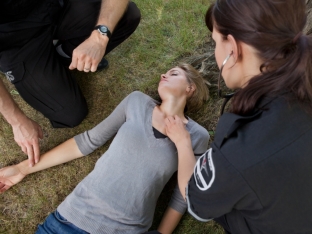Emergencies in aesthetic medicine can be triggered by both the administered drug and the patient's response to the methods of the procedure. The practitioner must remember that the introduction of any drug into the body can cause both a normal reaction and a pathological one. Unfortunately, adverse reactions are quite common and can lead to very serious conditions, including death. In this article, estet-portal.com offers a clear analysis of emergency conditions in aesthetic medicine, first aid protocol, as well as concomitant treatment.
Fainness and pre-syncope
The most common and mildest emergency is syncope. It often occurs in emotional patients and is most often the result of severe stress or a panic attack in response to a planned procedure.
In the practice of an esthetician, patients with fears such as fear of pain, blood, injections and needles are not uncommon. It is quite possible for such people to react to an upcoming or ongoing procedure with pre-syncope and fainting.
What is syncope and how it develops:
- oxygen starvation of the brain;
- sudden loss of consciousness of a non-epileptic nature;
- irritation n.vagus.
Physician action:
- Change the position of the patient's body to a supine position with an elevated lower section.
- Relieve the pressure of clothing if it interferes with blood flow to the head (scarves, ties, tight-necked clothing).
- For young patients who are pre-syncope, ammonia can be used.
In case of prolonged fainting and no response to the above measures, subcutaneous administration is used caffeine-sodium benzoate 1ml 10% solution.

Hypertensive crisis or sudden fluctuations in blood pressure
What is a hypertensive crisis characterized by:
- significant increase in blood pressure (200/110);
- circulatory disorders (neurovegetative type - acute rapid onset, facial redness, sweating; water-salt type (in chronic form) - slow onset, puffiness of the face, disorientation, edema).
Physician action:
- Change the patient's body position to lying down.
- Raise head section.
- Measure BP.
- Call an ambulance.
- Perform treatment aimed at lowering blood pressure (requires a decrease of 20-25% in the first 2 hours, no more).
Treatment for hypertensive crisis:
- Nifedipine/Finegedin 10 mg sublingually (calcium channel blockers needed to dilate blood vessels) - effect occurs within 20 minutes, can be repeated up to 3 times.
- Lasex.
- Corvalol/Validol (to calm the patient; do not have a hypertensive effect).
- Furasemide IM or tablets.
- Captopril (an APL inhibitor).
Brain Stroke: Emergency
What is a cerebral stroke characterized by:
- a sharp decrease in cerebral blood flow;
- development of tissue necrosis;
- people with chronic diseases (cardiovascular system, endocrine disorders and connective tissue diseases) are predisposed.
Physician action:
- Collect a detailed history (Anamnesis morbi).
- Monitor the patient's motor skills (contact / not contact, whether he talks, whether he can express emotions).
- Change the position of the patient's body to the supine position, raise the head section by 30 degrees, turn the head to one side (we are afraid of the tongue falling or obstruction of the upper respiratory tract).
- Measure BP.
- Call an ambulance and contact relatives.
Treatment for cerebral stroke:
- For high blood pressure (only if it is above 220/120) slowly reduce BP: Nifedipine/Finegedin 10 mg sublingually.
- If an oxygen tank is available, put on the patient a mask and apply medium or low current of medium concentrated O2.
- Infuse NaCl 0.9% (100 ml per hour).
When performing any procedure, the doctor must be prepared for unexpected reactions from the patient, be able to provide care for emergencies, take proper care of the patient and protect himself.
Read also: Anaphylactic shock develops: what should a cosmetologist do







Add a comment